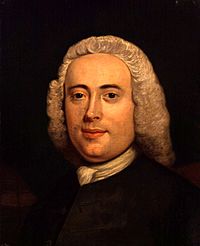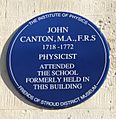John Canton facts for kids
Quick facts for kids
John Canton
|
|
|---|---|

John Canton
|
|
| Born | 31 July 1718 Stroud, Gloucestershire, England
|
| Died | 22 March 1772 (aged 53) |
| Citizenship | British |
| Known for | Electrostatic induction Pith-ball electroscope Artificial magnets Compressibility of liquids Canton’s phosphorus |
| Awards | Copley Medal (1751), (1764) |
| Scientific career | |
| Fields | Physics |
John Canton (born 31 July 1718 – died 22 March 1772) was an important physicist from Great Britain. A physicist is a scientist who studies how matter and energy work. He was born in a town called Stroud in England. Even as a schoolboy, John Canton showed he was very clever. He was the first person to figure out the exact latitude (how far north or south a place is) of his hometown by making a sundial.
His sundial caught the eye of Dr. Henry Miles, a famous scientist from the Royal Society. Dr. Miles encouraged John Canton to move to London to become a teacher. He worked with Samuel Watkins, who ran a school, and later became his business partner.
Contents
Discoveries and Inventions
Making Magnets and Understanding Electricity
In 1750, John Canton shared a new way to make artificial magnets. These were magnets made by people, not found naturally. He presented his ideas to the Royal Society, a group of important scientists. Because of his work, he was chosen to be a member of the Royal Society.
In 1751, he won the Copley Medal. This is a very special award given for important scientific discoveries. He received it for his clever method of making magnets without using natural ones.
John Canton was also a pioneer in understanding electricity. He was the first person in England to prove that lightning is a form of electricity. This was an idea first suggested by Benjamin Franklin. Canton also made several other big discoveries about electricity.
Testing Water and Creating Light
In the 1760s, John Canton did experiments that proved something surprising. Many scientists at the time believed that water could not be squeezed or compressed. But Canton showed that water actually can be compressed, even if only a tiny bit.
In 1768, he found a way to make a special material that glows in the dark. He made it by heating oyster shells with sulfur. This glowing material became known as "Canton's phosphorus." It's a type of phosphorescent material, meaning it absorbs light and then slowly releases it, making it glow.
John Canton made all these amazing discoveries while working as a school teacher. He passed away in London at the age of 53 due to an illness.
Helping with Math Ideas
John Canton also played a role in sharing important mathematical ideas. He helped publish letters from another mathematician, Thomas Bayes. These letters contained ideas that became the basis for what is now known as Bayes' Theorem. This theorem is a very important concept in probability and statistics. John Canton received these letters from an intermediary after Thomas Bayes had died, with Richard Price helping to connect them.
Legacy
Today, John Canton is best remembered for his work with electrostatics. This is the study of electric charges that are not moving. He invented the pith-ball electroscope, a simple device used to detect electric charges. He also did important studies on atmospheric electricity, which is about electricity in the air, like lightning.
There is a special blue plaque in his hometown of Stroud. It marks the place where his old school was, honoring his contributions to science.
Images for kids
Error: no page names specified (help). In Spanish: John Canton para niños
In Spanish: John Canton para niños


